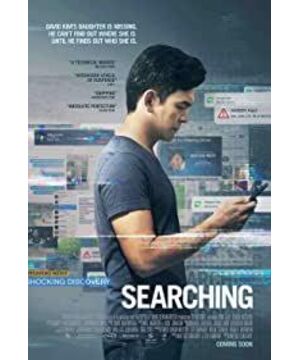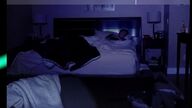Since its premiere at the Sundance Film Festival in the United States at the beginning of the year, "The Internet" has received too many compliments. The film hit theaters in mainland China on Friday and is currently being shown.
This is a movie where the whole movie takes place on electronic screens, computers, mobile phones, dash cams, web pages, videos, folders. The familiar contemporary daily life becomes a unique viewing experience. A novel method of shooting that reaches the audience with almost no obstacles. Together with South by Southwest's "Unfriend 2: The Dark Web" and Berlin's "Crystal", "On the Net" can jointly mark the arrival of the first year of tabletop cinema.
Matching the extreme form, "The Lost on the Internet" tells a story with twists and turns. The suspenseful atmosphere is properly controlled, the reversal creates high-energy and effective, and finally successfully pushes the emotions to a climax. In addition to the catchy main story, the film also cleverly mobilizes the elements of the picture and sound, adding some interesting aspects of computer operation, network use, and user personality to the plot from time to time, and the details are also very thoughtful.
The whole online "Internet Lost Tracking", intuitively, is like the live screen recording you watch on weekdays. But the behind-the-scenes information of "shooting for thirteen days and two years later" reveals that its production is far from simple. Even if it's low cost, it's about $1 million low cost, and it's not about turning on the camera at will. It's a wonderful story, the script plays a big part, and the editing takes a lot of work.
Behind the smooth operation of "Network Lost", a large number of designs are laid out, which makes it fundamentally different from screen recording and live broadcasting. If the "One Shot" of the "Unfriending" series can be compared to a long shot of a desktop movie, where the screen playing time is equal to the time of the story, then "The Internet Lost" shows the montage that can be achieved in the desktop movie interface.
Whether it's the family growth spanning many years in the opening scene, or the screen saver when you are asleep in the first act, time is compressed and omitted by "The Internet Lost" in a seemingly casual way. For the message the creator wanted to stand out, the film didn't hesitate to use close-ups, moves, leads, cues. There is also passive music in the film, but because of the long form and plot layout, the audience has been immersed, so it is not abrupt.
Therefore, the immersive feeling of "The Internet Lost" does not lie in the 1:1 copy. Lacking the "Unfriend" series or the improvisation of a live screencast, inside the desktop, it's doing precise calculations, screeding and editing from start to finish.
The difference is that in the scene scheduling and editing here, the subject of the object is not necessarily a person - it may be a page, a pop-up window, the overlapping of program boxes, or even the movement of the mouse. The audience can feel that the direction and speed of the mouse movement, the hesitation of pulling and clicking, all represent the action state of the character. After the text is entered, change, delete, send or not send, all describe the inner activities of the character.
These are things that traditional movies can't do, and are the most unique things about tabletop movies. The point isn't the choice of the framing frame, it's just another level of concealment of the camera. The novelty is what can be expressed in it. The activity on the electronic screen brings the audience into the interior of human behavior, reflecting unprecedented mental movements. The operation is the expression and the action, the performance. And the face in the video is just a counter-attack of the operation.
Therefore, if the form of a tabletop movie is regarded as a certain film language, it may be similar to an inner monologue, a voice-over - the sentence that is typed out but not spoken; it can also easily complete the flashback action in time - open Folders, watch a video shot many years ago; quickly connect different spaces - through Internet streaming, to cities, theaters, investigation sites, and any stranger's home who is willing to post a selfie online.
To sum up, although "Under the Net" only takes place on the electronic devices of members of a family, it actually travels through multiple sets of time and space, repeatedly wandering between the external actions and inner activities of the characters. Among them, the most difficult to be copied by traditional movies is the subtext of those subtle operations: a quick click represents anxiety, the option of undo symbolizes hesitation, and a paused mouse indicates unexpected discovery.
Thus, the form has a certain rationality for the story. If the shell of the desktop movie is removed, the story may be able to be told, but a lot of the above inner activities will be lost. But does it have to be in this format for the entire film? In several places, the film transitions to concerts and news scenes, and the narrative is not out of touch. The director zooms out and pulls them back to the web page and screen. The question is, what if you don't pull the lens back?
It is true that for "The Internet Lost", the story is applicable, the form is unified, and it is complete. But what about a different story? Wouldn't the whole movie seem rather obsessive in this extreme form? If a movie wants to paint the heart through the electronic screen, but does not want to be stuck in such a form all the time, what should it do? In other words, how can tabletop movies be combined with traditional live-action movies?
For example, in the climax of "I'm Not the God of Medicine", Sihui communicates news to patients through the computer network. The film also shows a similar electronic screen interface, and finally, through the countless faces on the screen, it is assembled into a large group photo of patients. However, this virtual group photo, which does not exist in any actual space, has become the most dramatic scene of the entire film based on realism, which makes it seem too sensational.
"The Nameless" also uses electronic screens, and the surveillance video stolen by two stupid thieves was edited into a ghost video by netizens. Its function is more practical, explaining cause and effect, driving the narrative, and playing a comedic role, and it also completes the ad placement with a clever twist. Importantly, this means that electronic screens are everywhere, and they can provide a storytelling angle that goes beyond the usual. A phone with a screen that doesn't light up is a worthless and useless sample.
Perhaps Jia Zhangke's explanation of "Children of Jianghu" is more interesting. He wrote on Weibo:
"The movie ends with a blurry image of Zhao Tao on the surveillance screen. We can't see her expression clearly. This is not the end of the original script. This is a blurry digital image with a strong sense of digital. In life, this is garbage that can be deleted at any time. The picture. The movie spends two hours talking about these vague figures, everyone has such a vivid story, and the film just doesn’t want these figures to be deleted arbitrarily.”
It is foreseeable that tabletop movies will spring up in the next few years. However, the whole process is in the horizon of the electronic screen. The first time is surprising, the second time is ordinary, and the third time may be aesthetic fatigue. The key thing to realize is that even in traditional movies, parts of the human soul have moved to the table. Poor mountains and bad waters and long shots are a reality, and the glory of the king of Kuaishou Douyin is the reality of this era.
Linking the two realities, so that they can transition seamlessly, may be the real direction of future movies. In 1947, "Beautiful Corpse on the Lake" used the first-person subjective lens throughout the whole process. The innovation is a fact, but it is too extreme to continue. Until today, POV has become a kind of film language, the stitching is perfect, and the camera is the eye. Therefore, it is not only tabletop movies that will come, but a more appropriate combination with traditional movies.
Having said that, the title of the first year of desktop movies should not be limited to the desktop operation display in the narrow sense. In fact, "Ready Player One", "Invincible Destruction King 2: Havoc on the Internet" and "Adventurer's Game: Battle in the Jungle" are all breaking the meta wall at this level, but they transform electronic content, regardless of code, symbols, programs, into anthropomorphic morphed role. What welcomes people in the future will be an inner world, a multidimensional reality.
As a digression, it is no surprise that when the resources of "Online Lost" were released, it became a hit on the Internet. But it is actually released in mainland theaters, the situation is a bit subtle. Because most of the websites and software used in the film are not available to mainland audiences, which is a bit ironic.
At this time, it has been about ten years since Facebook YouTube was banned. It is easy to translate subtitles. How to translate these interfaces, programs, buttons, dialog boxes, and operations, and explain why they are absent, the answer involves more than technology.
It just echoes the theme of "The Internet Lost": it is not the network and technology that hinders communication, stop blaming those images, sounds and codes. Ignorance, indifference, paranoia, cowardice or ignorance are the real causes of misunderstanding and prejudice. It is only by crossing the city wall, crossing the cable, and keeping the true from the false, that people can try to understand and embrace each other.
View more about Searching reviews











